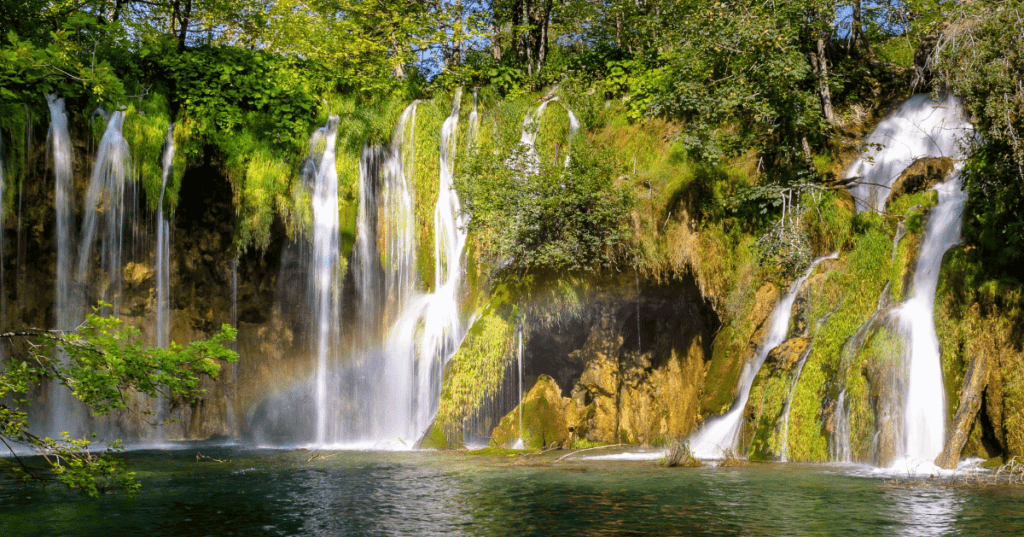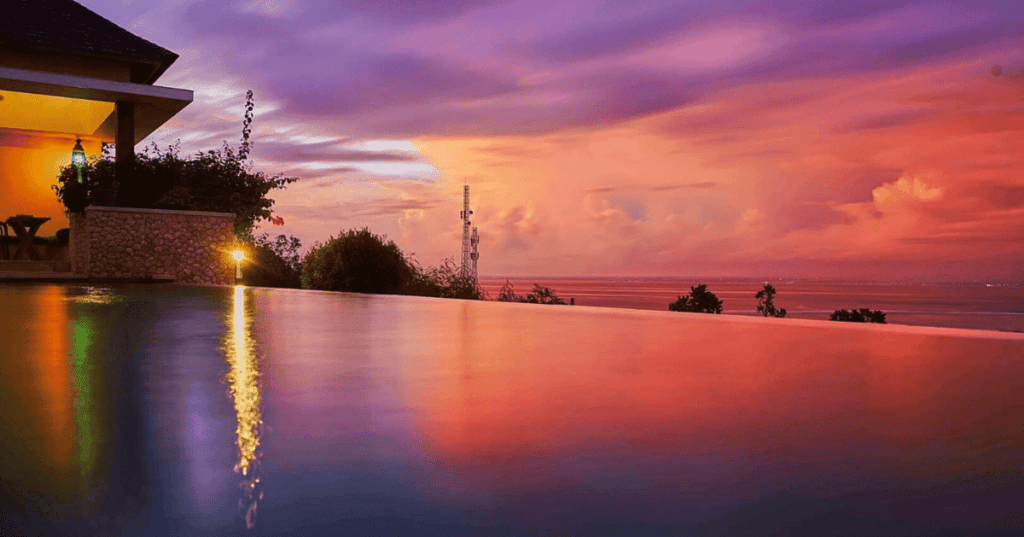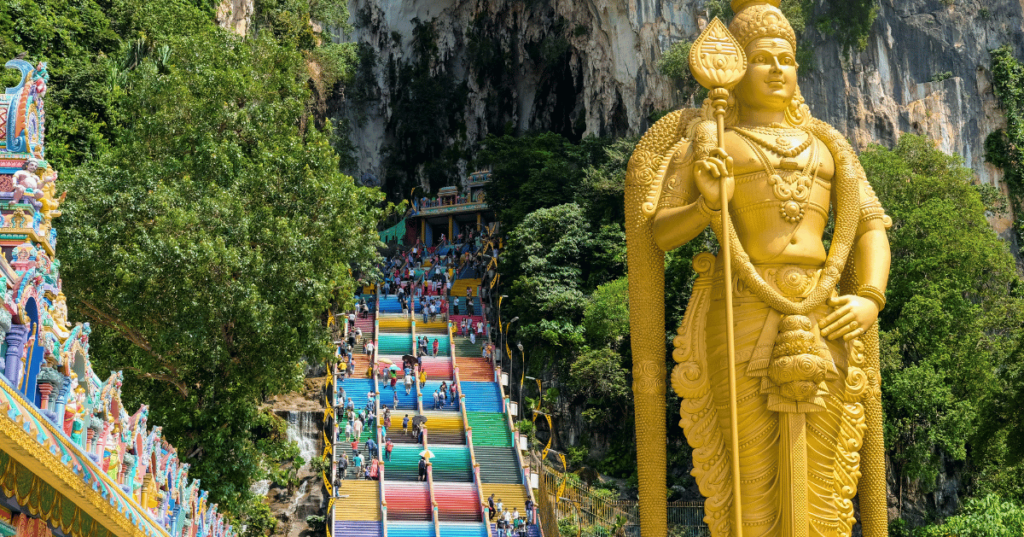The temples of Chiang Rai are something you won’t forget. They offer a combination of beauty, history, and culture. When I first visited, I was surprised by how different each was.
Among the things you’ll find at Wat Rong Khun are its bright white and strange, amazing details. There’s also Wat Phra Kaew, which is quiet, ancient, and bursting with history. Wat Huay Pla Kang, with its giant statue, is one of the most famous temples in the area.
If you’re heading to Chiang Rai, these temples should be at the top of your list. I’ll walk you through what makes each one special and give you a few tips to make your visit even better.
Why these three temples are must-visits
Every single one is different. It is like walking into a fantasy land at Wat Rong Khun, also known as the White Temple, with its dazzling white design and contemporary artwork.
Wat Phra Kaew is a must for history buffs. It’s where the famous Emerald Buddha was discovered, and it offers a peaceful, traditional experience away from the city’s hustle.
Wat Huay Pla Kang is hard to miss with its giant Guan Yin statue. It’s a mix of Thai and Chinese influences, and the views from the top are spectacular. Each temple provides a different experience, making them all worth a visit.
1. Wat Rong Khun: The White Temple

The Story Behind the White Temple
Wat Rong Khun, or the White Temple, was created by Thai artist Chalermchai Kositpipat. He wanted to build a modern temple that blends traditional Buddhist ideas with new art.
Construction started in 1997, and the temple’s all-white color stands for purity. The mirrors on the building reflect wisdom. The Bridge of Rebirth symbolizes moving from suffering to enlightenment. Inside, the murals mix old Buddhist symbols with modern pop culture.
In 2014, an earthquake damaged the temple, but Chalermchai worked hard to repair it. Today, the White Temple continues to be a unique blend of art and spirituality.
Location and Hours of Operation
Wat Rong Khun is located about 13 kilometers south of Chiang Rai’s city center, along Highway 1. It’s easy to reach by car, tuk-tuk, or even bike if you’re up for a bit of exercise. The temple is open daily from 8:00 AM to 5:00 PM, so you’ve got plenty of time to explore, but it’s best to go early to avoid the crowds.
Ticket Prices and Other Fees
Wat Rong Khun charges a small entry fee of 50 THB for foreigners. It’s a fair price considering the upkeep required for such a detailed and unique place. There’s no additional fee to wander the grounds, but donations are always welcome if you want to contribute.
Key Attractions of Wat Rong Khun (White Temple)

1. The Main White Building (Ubosot)
The centerpiece of Wat Rong Khun is the dazzling white main hall or ubosot. Covered in intricate carvings and tiny mirror fragments, it symbolizes purity and wisdom. As you approach, you’ll notice the intricate details that represent Buddhist teachings, like the cycle of life and the path to enlightenment.
2. The Bridge of Rebirth
To enter the main hall, you cross the Bridge of Rebirth. The hands reaching up from below represent human desire and suffering, a reminder of the challenges one must overcome on the path to enlightenment.
3. The Gate of Heaven
This part of the temple represents Buddhist beliefs about karma and the afterlife. As you cross the bridge, you’ll find yourself at the Gate of Heaven, guarded by two mythical creatures.
4. The Golden Building
Interestingly, not everything is white at Wat Rong Khun. The golden building, which contrasts sharply with the rest of the temple, houses the restrooms. It represents worldly desires, such as wealth and materialism, in contrast to the purity of the white structures.
5. Murals Inside the Ubosot
The interior of the temple is just as fascinating, with contemporary murals that mix Buddhist themes with modern pop culture references, including characters from movies like The Matrix and Star Wars. These murals symbolize the coexistence of the spiritual and the material worlds.
6. The Meditation Hall and Art Gallery
Near the temple, you can also explore a meditation hall and art gallery showcasing works by Chalermchai Kositpipat, the artist behind Wat Rong Khun. His art combines modern elements with traditional Buddhist themes, offering a deeper look into his vision.
Tips for Visiting White Temple
- Go early: The temple can get crowded, so showing up when it opens gives you a more peaceful experience.
- Dress appropriately: Like all temples in Thailand, you’ll need to cover your shoulders and knees. Bring a scarf or shawl if you’re unsure.
- Respect the art: While you’ll want to take lots of photos, be mindful of signs that indicate where photos are not allowed—especially inside the main hall.
2. Wat Phra Kaew: The Temple of the Emerald Buddha
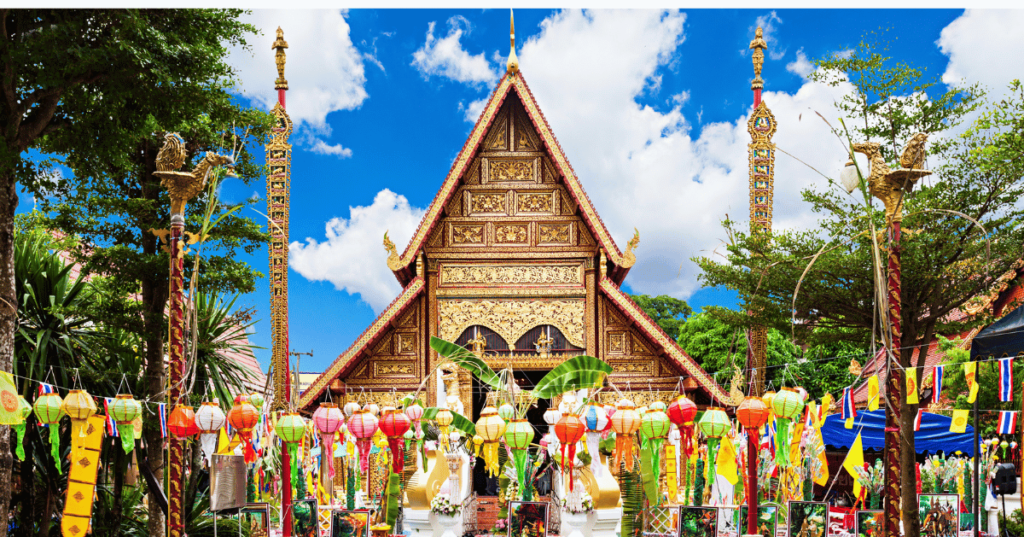
The Story Behind Wat Phra Kaew Temple
Wat Phra Kaew is one of the most important temples in Thailand. It’s famous for being the original home of the Emerald Buddha, a sacred statue that was discovered here in 1434.
According to legend, the Buddha was found inside a stupa after lightning struck it, revealing the statue inside. Today, the Emerald Buddha resides in Bangkok, but this temple remains a significant historical and spiritual site.
Location and Hours of Operation
Wat Phra Kaew is located in the heart of Chiang Rai, making it easy to visit. The temple is open every day from 7:00 AM to 6:00 PM, giving you plenty of time to explore.
Ticket Prices and Other Fees
Good news—there’s no entrance fee for Wat Phra Kaew! It’s free for everyone, but donations are always appreciated to help maintain the temple.
Key Attractions of Wat Phra Kaew: The Temple of the Emerald Buddha
The Emerald Buddha
The main highlight of Wat Phra Kaew is the Emerald Buddha, a small but highly revered statue. It’s housed in the temple’s central chamber and is covered in a golden robe. This statue is a symbol of Thailand’s spiritual heritage and is believed to bring prosperity and protection.
The Chapel of the Emerald Buddha
The Chapel, or ubosot, where the Emerald Buddha is enshrined, is a beautifully decorated space with intricate murals and detailed craftsmanship. The interior design reflects traditional Lanna and Thai art, adding to the temple’s spiritual ambiance.
The Outer Court and Royal Pantheon
The Outer Court features various important buildings, including the Royal Pantheon, which displays royal relics and statues. This area showcases the grandeur of Thai architecture and the importance of the temple in Thai royal history.
The Cloister Walkway
The temple complex includes a cloistered walkway that encircles the central area. It’s adorned with beautiful murals depicting the life of the Buddha and important historical events. Walking along this walkway provides a deeper understanding of Buddhist teachings and Thai culture.
The Emerald Buddha Museum
On-site, you’ll find a small museum with exhibits about the history of the Emerald Buddha and its significance. This museum offers additional context about the statue and the temple’s role in Thai history.
Tips for Visiting
- Dress modestly: As with all temples, make sure your shoulders and knees are covered.
- Take your time: This isn’t a large temple, but it’s filled with history, so take a moment to appreciate the details.
- Visit the museum: The small museum gives insight into the temple’s importance and the Emerald Buddha’s history.
3. Wat Huay Pla Kang: The Giant Buddha and Pagoda
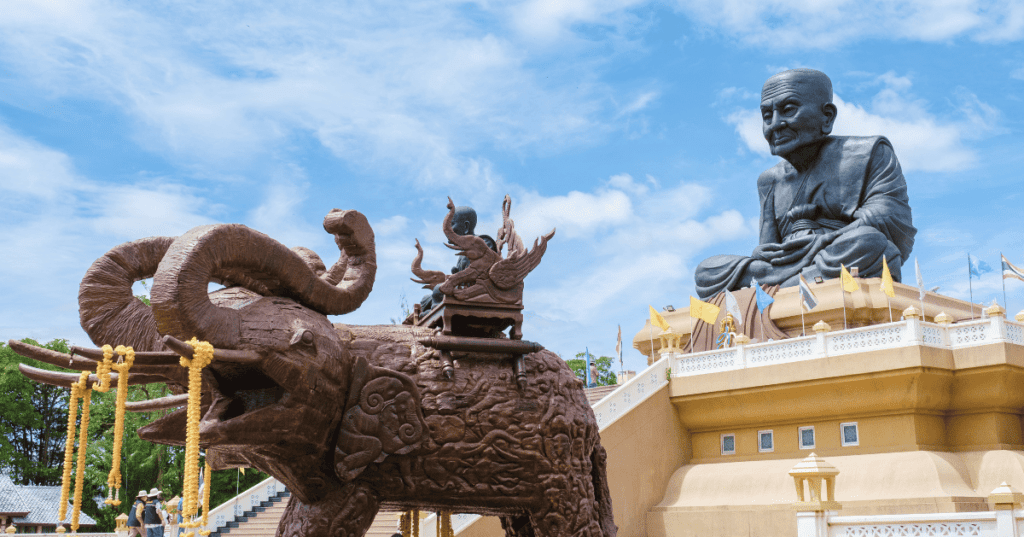
The Story Behind Wat Huay Pla Kang
In contrast to the other temples in Chiang Rai, Wat Huay Pla Kang is a relatively new temple, but it has quickly become a landmark. There is an impressive statue of Guan Yin, the Goddess of Mercy, standing 90 meters high in this temple.
A Buddhist temple with a strong focus on helping the local community, it blends Thai and Chinese influences. It’s a tranquil space dedicated to meditation and compassion.
Location and Hours of Operation
Wat Huay Pla Kang is located about 6 kilometers north of Chiang Rai’s city center, nestled in a scenic area. The temple is open daily from 7:00 AM to 9:30 PM, so you can visit even later in the day to see the sunset.
Ticket Prices and Other Fees
Entrance to the temple grounds is free, but there’s a small fee (40 THB) to take the elevator inside the Guan Yin statue, which offers stunning views of the surrounding area.
Key Attractions of Wat Huay Pla Kang: The Giant Buddha and Pagoda
1 The Giant Guan Yin Statue
The standout feature of Wat Huay Pla Kang is its massive statue of Guan Yin, the Goddess of Mercy. Standing at 90 meters tall, it’s a striking sight and a symbol of compassion. The statue is visible from afar and offers a powerful, serene presence.
2: The Elevator Ride Inside the Statue
Inside the Guan Yin statue, there’s an elevator that takes you up to an observation deck. From here, you can enjoy panoramic views of the surrounding area and appreciate the statue’s impressive scale.
3: The Nine-Tiered Pagoda
The temple complex includes a beautiful nine-tiered pagoda. Each level of the pagoda is adorned with intricate designs and offers a unique perspective on the temple grounds. It’s a great place to explore and take in the detailed architecture.
4: The Peaceful Gardens
Wat Huay Pla Kang is surrounded by tranquil gardens that provide a relaxing atmosphere. These gardens are perfect for a peaceful stroll and reflection, adding to the temple’s serene environment.
5: Cultural Fusion Elements
The temple blends Thai and Chinese architectural styles, reflecting the cultural mix in its design and decoration. This fusion makes Wat Huay Pla Kang unique among Chiang Rai’s temples and adds to its visual appeal.
Tips for Visiting
- Take the elevator ride: It’s worth the small fee to go up to them and enjoy the views.
- Plan for a peaceful visit: This temple is a great spot for relaxation and reflection, so take your time walking around the grounds.
- Visit in the late afternoon: The light at sunset makes the temple even more beautiful, especially with the views from the top.
How to Plan Your Visit to Chiang Rai’s Temples
Planning your visit to Chiang Rai’s temples is straightforward, but a little prep goes a long way in making the most of your trip. Here are some tips to help you organize:
- Timing Your Visit: Start early in the morning to beat the crowds and the heat. Wat Rong Khun tends to get busy, so arriving when it opens (8:00 AM) gives you a more peaceful experience. Wat Phra Kaew and Wat Huay Pla Kang are quieter, but visiting Wat Huay Pla Kang in the late afternoon is great for sunset views.
- Getting Around: The temples are spread out, so hiring a tuk-tuk or renting a car or scooter is a good idea. Most tuk-tuk drivers offer half-day or full-day temple tours, which is a convenient way to cover all three spots.
- What to Wear: Dress modestly when visiting any Thai temple. Shoulders and knees should be covered—bring a light scarf or shawl if needed. Comfortable shoes are also important since you’ll be walking a lot.
- Entrance Fees: While Wat Phra Kaew is free, Wat Rong Khun and Wat Huay Pla Kang charge small fees (50 THB and 40 THB, respectively). Bring some extra cash for donations or small purchases.
- Staying Hydrated: Chiang Rai can get hot, especially if you’re visiting during the day. Carry water with you and take breaks in shaded areas when needed.
With these tips in mind, you’ll be all set to enjoy the stunning temples of Chiang Rai at your own pace.
Final Thoughts on Chiang Rai’s Temples
Chiang Rai’s temples offer a unique mix of art, history, and spirituality. Whether you’re marveling at the modern, dazzling design of Wat Rong Khun, stepping back in time at the historic Wat Phra Kaew, or taking in the peaceful blend of Thai and Chinese influences at Wat Huay Pla Kang, each temple gives you something different to experience.
What makes these temples truly special is how they reflect the diverse aspects of Thai culture—from contemporary creativity to ancient traditions and a sense of calm and reflection. They’re not just places to visit, but spaces to connect with the deeper meanings behind the art and architecture.
If you’re exploring Chiang Rai, these temples are must-sees that will leave you with a lasting impression of the city’s rich spiritual and cultural heritage.
Frequently Asked Questions About Chiang Rai’s Temples
Q1: Do I need to buy tickets in advance to visit the temples?
No, you don’t need to buy tickets in advance. You can purchase them on-site at Wat Rong Khun and Wat Huay Pla Kang. Wat Phra Kaew is free to enter.
Q2: What should I wear when visiting the temples?
Modest clothing is required at all temples. Make sure your shoulders and knees are covered. If you’re unsure, carry a light scarf or shawl to cover up.
Q3: Can I take photos inside the temples?
Photography is usually allowed outside the temples. However, some temples may restrict photography inside sacred areas, so always check for signs or ask temple staff.
Q4: How much time should I set aside for visiting each temple?
Plan for around 1–2 hours at each temple to explore the grounds, take photos, and appreciate the architecture. If you’re short on time, you can visit all three temples in a half-day.
Q5: What’s the best time to visit the temples?
The best time to visit is early morning or late afternoon to avoid crowds and enjoy cooler temperatures. Wat Huay Pla Kang is particularly stunning during sunset.
Q6: Are the temples wheelchair accessible?
Accessibility varies by temple. Wat Rong Khun has some ramps, but certain areas might be difficult to access. It’s best to check with the staff or call ahead if you need specific accommodations.



